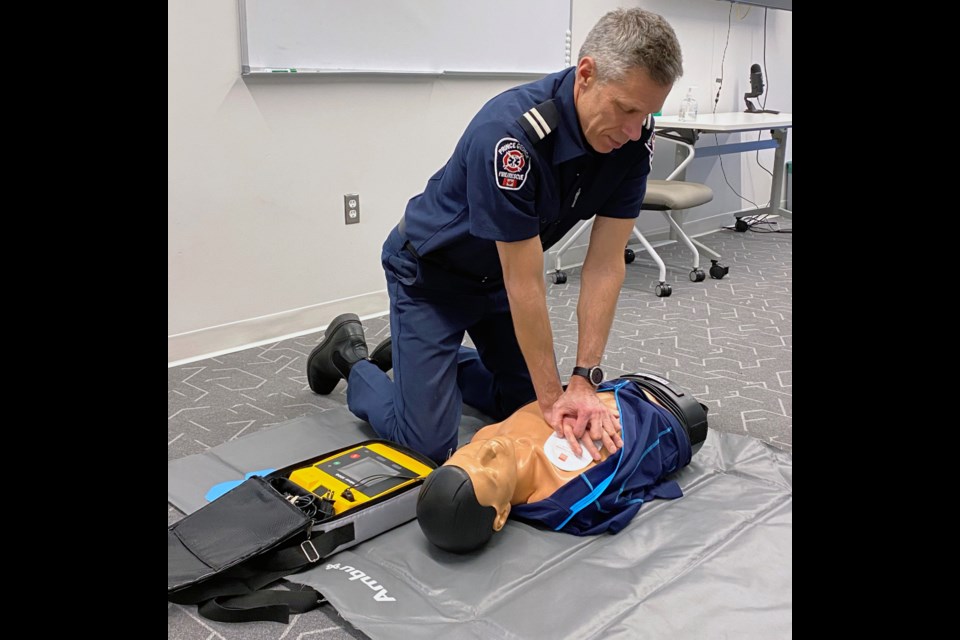As a career firefighter for Prince George Fire Rescue, Colin Groeneveld has seen dozens of people in medical distress and knows the consequences of a life-threatening incident when help does not arrive in time.
If it’s a case of cardiac arrest, chances are that patient will die unless someone is there to intervene with cardiopulmonary resuscitation (CPR).
If you suspect someone has suffered a heart attack or has suffered some other medical trauma that stops their heartbeat and keeps them from breathing, the clock is ticking. Even if you’ve had no first aid training, Groeneveld says any attempt at CPR is better than doing nothing.
“I’ve seen people literally playing cards at the table while somebody was laying beside them unresponsive in cardiac arrest when we walked in there,” said Groeneveld, P.G. Fire Rescue’s emergency medical responder co-ordinator.
“Sometimes if people don’t know what to do they’re worried about helping somebody out. Nobody should be worried about someone you see at home or on the street. At minimum you can call 9-1-1 and you’re protected by the Good Samaritan Act. If you have good intentions and you’re helping someone to the best of your abilities, even if it’s not the best CPR, that’s good enough.”
In recent years many public buildings, retail stores and private businesses have installed automated external defibrillators (AED). Stored in a padded case that would fit a tablet computer and usually mounted in a steel box on a wall, the machine emits verbal instructions to walk the user through the entire process. The machine is geared to be used by someone without any medical expertise and it will talk you through the process. If needed, will deliver an electric shock that zaps the heart to get it beating on its own again.
Each AED has two sticky pads (electrodes) that have to be plugged into the machine which determines if and when an electric shock is needed. The upper torso area has to be exposed, with all clothing removed, for the pads to be properly applied to bare skin. The AED issues a command ‘clear’ which alerts the user to not be in contact with the patient when the electric shock is delivered.
“Most of the time (the heart is) not stopped, it’s quivering or fibrillating and it’s not pumping blood properly,” said Groeneveld. “The good thing about AEDs is they won’t hurt someone. They won’t shock someone unless it detects a shockable rhythm.”
If a patient is showing no signs of revival and is not moving or breathing, that means more chest compressions should be applied. When doing CPR, the attendant should be on either side of the patient with hands placed on top of each other, pressing on the centre of the chest.
If the attendant is well-trained in CPR and has the skills to provide artificial respiration, it’s recommended to provide two rescue breaths for every 30 chest compressions. But for most people, hands-only CPR will be enough to prolong life and prevent damage to the brain and vital organs in most cases because the blood will stay well oxygenated for several minutes without artificial respiration.
“Hands-only CPR is excellent, it’s shown to be very effective,” said Groeneveld. “Especially with adults, it works very well. That means you don’t have to worry about breathing into somebody.
“If everybody could have chest compressions before that AED comes on, you would see (more people surviving cardiac arrest).”
Groeneveld knows of one case in which hands-only CPR kept a man alive for 30 minutes and he made a full recovery without brain damage. With no intervention, brain damage can occur within four minutes and with no blood circulation for 10 minutes the damage is usually irreversible.
Ideally, between 100 and 120 chest compression each minute should be applied. To help find the proper rhythm try to mimic the beat of the Bee Gees hit song, Stayin’ Alive. The chest should be compressed at least five centimetres and with each upstroke lift your hands off the patient high enough to get put a slip of paper underneath, which allows the chest to fully recoil before the next compression.
There is a chance while doing chest compressions of breaking the patient’s ribs but the benefits far outweigh the risks.
“Doctors can repair ribs; they can’t repair death,” said Groeneveld.
He says people should continue with CPR until a trained first responder arrives. A patient might make gasping sounds fighting for breath but Groeneveld says that can fool a first aid attendant to stop CPR when that intermittent breathing is actually a sign they are still suffering cardiac arrest.
Canada has an estimated 40,000 cardiac arrest cases per year, that’s about one over 12 seconds.
Groeneveld says every city resident should take at least one CPR course. The 100 PGFR firefighters continually upgrade their medical training and set aside one evening shift per week to refresh their EMR skills.
The location of AEDs in the city are mapped out on an app called PulsePoint AED.
Prince George-Valemount MLA Shirley Bond is encouraging all businesses that have an AED to register its location with the app to create more public awareness and help avoid time delays in the case of an emergency.


